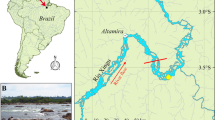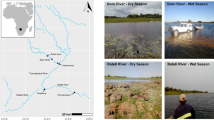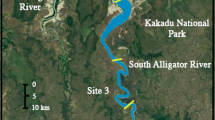Abstract
High levels of hydrological connectivity during seasonal flooding provide significant opportunities for movements of fish between rivers and their floodplains, estuaries and the sea, possibly mediating food web subsidies among habitats. To determine the degree of utilisation of food sources from different habitats in a tropical river with a short floodplain inundation duration (~2 months), stable isotope ratios in fishes and their available food were measured from three habitats (inundated floodplain, dry season freshwater, coastal marine) in the lower reaches of the Mitchell River, Queensland (Australia). Floodplain food sources constituted the majority of the diet of large-bodied fishes (barramundi Lates calcarifer, catfish Neoarius graeffei) captured on the floodplain in the wet season and for gonadal tissues of a common herbivorous fish (gizzard shad Nematalosa come), the latter suggesting that critical reproductive phases are fuelled by floodplain production. Floodplain food sources also subsidised barramundi from the recreational fishery in adjacent coastal and estuarine areas, and the broader fish community from a freshwater lagoon. These findings highlight the importance of the floodplain in supporting the production of large fishes in spite of the episodic nature and relatively short duration of inundation compared to large river floodplains of humid tropical regions. They also illustrate the high degree of food web connectivity mediated by mobile fish in this system in the absence of human modification, and point to the potential consequences of water resource development that may reduce or eliminate hydrological connectivity between the river and its floodplain.




Similar content being viewed by others
References
Bayley PB (1991) The flood pulse advantage and the restoration of river–floodplain systems. Reg Rivers Res Manage 6:75–86
Brooks S, Tyler CR, Sumpter JP (1997) Quality in fish: what makes a good egg? Rev Fish Biol Fisheries 7:387–416
Buchheister A, Latour RJ (2010) Turnover and fractionation of carbon and nitrogen stable isotopes in tissues of a migratory coastal predator, summer flounder (Paralichthys dentatus). Can J Fish Aquat Sci 67:445–461
Cabana G, Rasmussen JB (1996) Comparison of aquatic food chains using nitrogen isotopes. Proc Nat Acad Sci USA 93:10844–10847
Cunjak RA, Roussel JM, Gray MA, Dietrich JP, Cartwright DF, Munkittrick KR, Jardine TD (2005) Using stable isotope analysis with telemetry or mark-recapture data to identify fish movement and foraging. Oecologia 144:636–646
Davis TLO (1986) Migration patterns in barramundi, Lates calcarifer (Bloch) in Van Diemen Gulf, Australia, with estimates of fishing mortality in specific areas. Fish Res 4:243–258
De Graaf G (2003) Dynamics of floodplain fisheries in Bangladesh, results of 8 years fisheries monitoring in the Compartmentalization Pilot Project. Fish Manage Ecol 10:191–199
Douglas MM, Bunn SE, Davies PM (2005) River and wetland food webs in Australia’s wet–dry tropics: general principles and implications for management. Mar Freshw Res 56:329–342
Dudgeon D (2000) Large-scale hydrological changes in tropical Asia: prospects for riverine biodiversity. Bioscience 50:793–806
Finlay JC (2004) Patterns and controls of lotic algal stable carbon isotope ratios. Limnol Oceanogr 49:850–861
Fry B (2002) Stable isotopic indicators of habitat use by Mississippi River fish. J N Amer Benthol Soc 21:676–685
Gaston TF, Kostoglidis A, Suthers IM (2004) The 13C, 15N and 34S signatures of a rocky reef planktivorous fish indicate different coastal discharges of sewage. Mar Freshw Res 55:689–699
Hamilton SK, Sippel SJ, Melack JM (2002) Comparison of inundation patterns among major South American floodplains. J Geophys Res 107(D20):8038
Hunt RJ, Jardine TD, Hamilton SK, Bunn SE (2011) Temporal and spatial constraints on ecosystem metabolism and food web carbon transfer in a wet-dry tropical river. Freshw Biol (accepted)
Hutchings JA (1991) Fitness consequenes of variation in egg size and food abundance in brook trout Salvelinus fontinalis. Evolution 45:1162–1168
Jardine TD, Chernoff E, Curry RA (2008) Maternal transfer of carbon and nitrogen to progeny of sea-run and resident brook trout (Salvelinus fontinalis). Can J Fish Aquat Sci 65:2201–2210
Jardine TD, Pettit NE, Warfe DM, Pusey BJ, Ward DP, Douglas MM, Davies PM, Bunn SE (2011) Consumer–resource coupling in wet-dry tropical rivers. J Animal Ecol (accepted)
Jonsson KI (1997) Capital and income breeding as alternative tactics of resource use in reproduction. Oikos 78:57–66
Junk WJ, Wantzen KM (2004) The flood pulse concept: new aspects, approaches and applications—an update. In: Welcomme RL, Petr T (eds) Proceedings of the Second International Symposium on the Management of Large Rivers for Fisheries. FAO Regional Office for Asia and the Pacific, Bangkok
Junk WJ, Bayley PB, Sparks RE (1989) The flood pulse concept in river–floodplain systems. In: Dodge DP (ed) Proceedings of the International Large River Symposium (Canadian Special Publication of Fisheries and Aquatic Sciences). Canadian Government Publishing Centre, Ottawa, pp 110–127
Junk WJ, Brown M, Campbell IC, Finlayson M, Gopal B, Ramberg L, Warner BG (2006) The comparative biodiversity of seven globally important wetlands: a synthesis. Aquat Sci 68:400–414
Lae R (1995) Climatic and anthropogenic effects on fish diversity and fish yields in the central delta of the Niger River. Aquat Living Res 8:43–58
Lewis WM, Hamilton SK, Saunders JF (1995) Rivers of northern South America. In: Cushing CE, Cummins KW, Minshall GW (eds) River and stream ecosystems. Elsevier, Amsterdam, pp 219–256
Logan JM, Jardine TD, Miller TJ, Bunn SE, Cunjak RA, Lutcavage ME (2008) Lipid corrections in carbon and nitrogen stable isotope analyses: comparison of chemical extraction and modelling methods. J Anim Ecol 77:838–846
Loneragan NR, Bunn SE (1999) River flows and estuarine ecosystems: implications for coastal fisheries from a review and a case study of the Logan River, southeast Queensland. Aust J Ecol 24:431–440
MacAvoy SE, Macko SA, McIninch SP, Garman GC (2000) Marine nutrient contributions to freshwater apex predators. Oecologia 122:568–573
McCann KS, Rasmussen JB, Umbanhowar J (2005) The dynamics of spatially coupled food webs. Ecol Lett 8:513–523
McCutchan JH, Lewis WM, Kendall C, McGrath CC (2003) Variation in trophic shift for stable isotope ratios of carbon, nitrogen, and sulfur. Oikos 102:378–390
Milton D, Halliday I, Sellin M, Marsh R, Staunton-Smith J, Woodhead J (2008) The effect of habitat and environmental history on otolith chemistry of barramundi (Lates calcarifer) in estuarine populations of a regulated tropical river. Est Coast Shelf Sci 78:301–315
Mosepele K, Moyle PB, Merron GS, Purkey DR, Mosepele B (2009) Fish, floods, and ecosystem engineers: aquatic conservation in the Okavango Delta, Botswana. Bioscience 59:53–64
Petheram C, McMahon TA, Peel MC (2008) Flow characteristics of rivers in northern Australia: implications for development. J Hydrol 357:93–111
Phillips DL, Gregg JW (2001) Uncertainty in source partitioning using stable isotopes. Oecologia 127:171–179
Phillips DL, Gregg JW (2003) Source partitioning using stable isotopes: coping with too many sources. Oecologia 136:261–269
Phillips DL, Newsome SD, Gregg JW (2005) Combining sources in stable isotope mixing models: alternative methods. Oecologia 144:520–527
Polis GA, Anderson WB, Holt RD (1997) Toward an integration of landscape and food web ecology: the dynamics of spatially subsidized food webs. Ann Rev Ecol Syst 28:289–316
Pusey B, Kennard M, Arthington A (2004) Freshwater fishes of North-Eastern Australia. CSIRO, Collingwood
Quevedo M, Svanback R, Eklov P (2009) Intrapopulation niche partitioning in a generalist predator limits food web connectivity. Ecology 90:2263–2274
Robins JB, Halliday IA, Staunton-Smith J, Mayer DG, Sellin MJ (2005) Freshwater-flow requirements of estuarine fisheries in tropical Australia: a review of the state of knowledge and application of a suggested approach. Mar Freshw Res 56:343–360
Robins J, Mayer D, Staunton-Smith J, Halliday I, Sawynok B, Sellin M (2006) Variable growth rates of the tropical estuarine fish barramundi Lates calcarifer (Bloch) under different freshwater flow conditions. J Fish Biol 69:379–391
Rooney N, McCann K, Gellner G, Moore JC (2006) Structural asymmetry and the stability of diverse food webs. Nature 442:265–269
Russell DJ, Garrett RN (1983) Use by juvenile barramundi, Lates calcarifer (Bloch), and other fishes of temporary supralittoral habitats in a tropical estuary in northern Australia. Aust J Mar Freshw Res 34:805–811
Sogard SM (1997) Size-selective mortality in the juvenile stage of teleost fishes: a review. Bull Mar Sci 60:1129–1157
Staunton-Smith J, Robins JB, Mayer DG, Sellin MJ, Halliday IA (2004) Does the quantity and timing of fresh water flowing into a dry tropical estuary affect year-class strength of barramundi (Lates calcarifer)? Mar Freshw Res 55:787–797
Suzuki KW, Kasai A, Nakayama K, Tanaka M (2005) Differential isotopic enrichment and half-life among tissues in Japanese temperate bass (Lateolabrax japonicus) juveniles: implications for analyzing migration. Can J Fish Aquat Sci 62:671–678
Taylor BW, Flecker AS, Hall RO (2006) Loss of a harvested fish species disrupts carbon flow in a diverse tropical river. Science 313:833–836
Tockner K, Bunn SE, Gordon C, Naiman RJ, Quinn GP, Stanford JA (2008) Flood plains: critically threatened ecosystems. In: Polunin N (ed) Aquatic eosystems. Cambridge University Press, Cambridge, pp 45–61
Van Dover CL, Grassle JF, Fry B, Garritt RH, Starczak VR (1992) Stable isotope evidence for entry of sewage-derived organic material into a deep-sea food web. Nature 360:153–156
Vörösmarty CJ, McIntyre P, Gessner M, Dudgeon D, Prusevich A, Green P, Glidden S, Bunn SE, Sullivan C, Reidy C, Davies PM (2010) Global threats to human water security and river biodiversity. Nature 467:555–561
Ward D, Brooks A, Pusey B, Olley J, Shellberg J, Tews K, Spencer J, Knight J (2011) Riverine landscapes and aquatic systems diversity. In: Pusey B (ed) Aquatic biodiversity in northern Australia: patterns, threats and future. Charles Darwin University Press, Darwin, pp 5–22
Welcomme RL (2001) Inland fisheries: ecology and management (Food and Agriculture Organization). Blackwell, Oxford
Welcomme RL, Halls A (2003) Dependence of tropical river fisheries on flow. In: Welcomme RL, Petr T (eds) Proceedings of the Second International Symposium on the Management of Large Rivers for Fisheries. FAO Regional Office for Asia and the Pacific, Bangkok, pp 267–283
Winemiller KO, Kelso-Winemiller LC (1994) Comparative ecology of the African pike, Hepsetus odoe, and tigerfish, Hydrocynus forskahli, in the Zambezi River floodplain. J Fish Biol 45:211–225
Winemiller KO, Jepsen DB (1998) Effects of seasonality and fish movement on tropical river food webs. J Fish Biol 53(Suppl A):267–296
Acknowledgments
The authors thank Richard Hunt, Dominic Váldez, Stephen Faggotter, Courtenay Mills, Kate Masci, Alisha Steward, Colton Perna, Michael Pusey, Raven Greenwool, Anzac Frank, Taron David and Michael Gater for assistance with sample collection, Jeff Shellberg and Doug Ward for hydrology data, and Rene Diocares, Vanessa Fry and Laura Jardine for help with sample processing and isotope analysis. This work was conducted under the Tropical Rivers and Coastal Knowledge (TRaCK) Research Hub. TRaCK received major funding for its research through the Australian Government’s Commonwealth Environment Research Facilities initiative; the Australian Government’s Raising National Water Standards Program; Land and Water Australia; the Fisheries Research and Development Corporation, and the Queensland Government’s Smart State Innovation Fund.
Author information
Authors and Affiliations
Corresponding author
Additional information
Communicated by Leon Barmuta.
Electronic supplementary material
Below is the link to the electronic supplementary material.
Rights and permissions
About this article
Cite this article
Jardine, T.D., Pusey, B.J., Hamilton, S.K. et al. Fish mediate high food web connectivity in the lower reaches of a tropical floodplain river. Oecologia 168, 829–838 (2012). https://doi.org/10.1007/s00442-011-2148-0
Received:
Accepted:
Published:
Issue Date:
DOI: https://doi.org/10.1007/s00442-011-2148-0




